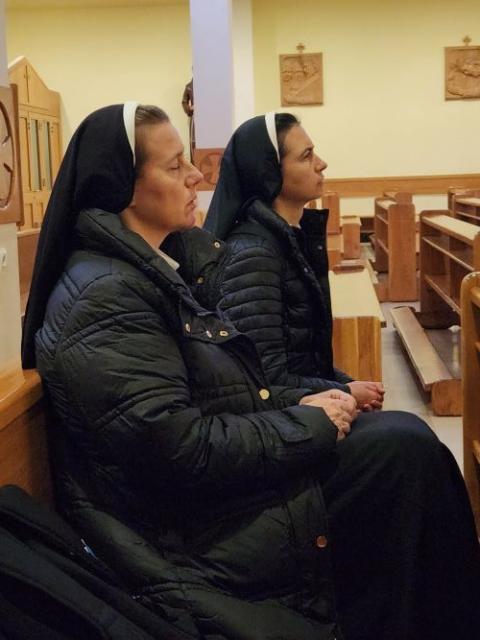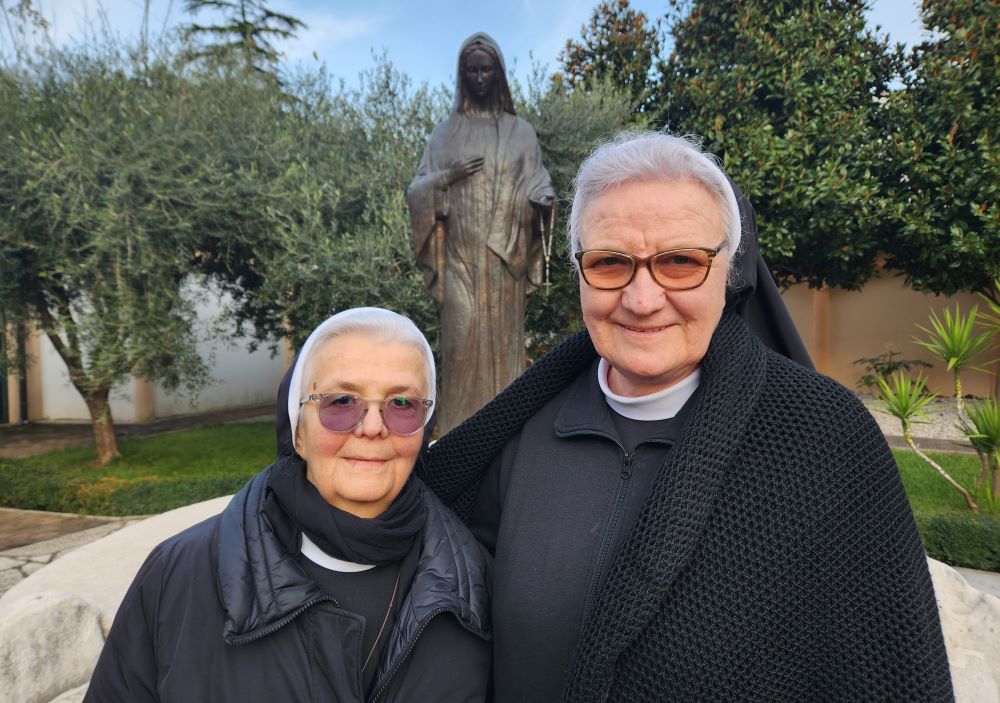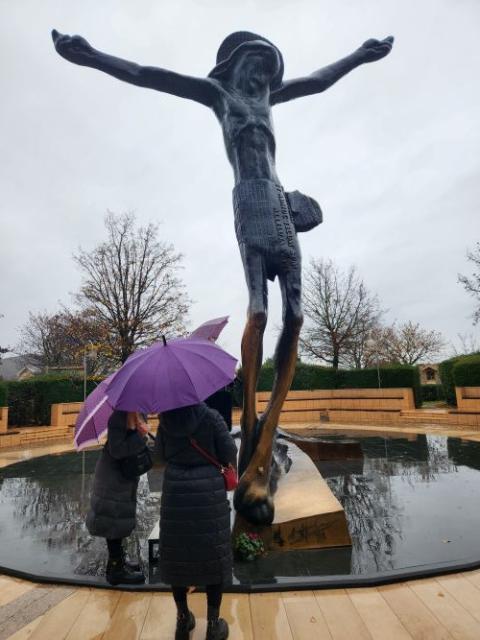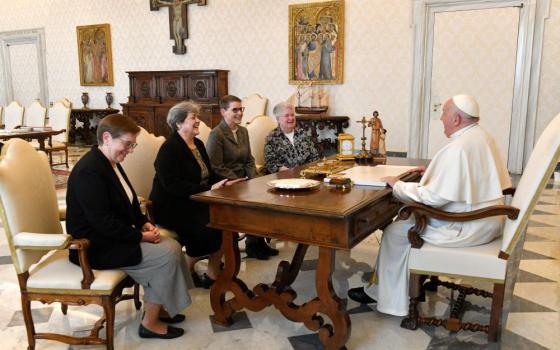
Pilgrims to the Marian shrine in Medjugorje, Bosnia and Herzegovina, pray at the Church of St. James. About 1 million pilgrims visit the shrine each year. (GSR photo/Chris Herlinger)
Editor's note: This is part of an occasional series of stories and columns about Marian shrines and devotions and how Catholic sisters are connected with them.

Srs. Adriana Galić, left, and Jelena Hrkać, School Sisters of St. Francis of Christ the King, pray at the Church of St. James at the Marian shrine in Medjugorje. (GSR photo/Chris Herlinger)
They come from throughout the world to pay homage to Our Lady of Medjugorje — apparitions, witnesses say, of the Virgin Mary, the mother of Jesus, that began in June 1981.
Six children — now adults — say they saw the apparitions. Since then, some 1 million pilgrims a year flock to embrace the special quality of this Marian shrine, located in a village 16 miles southwest from the city of Mostar, Bosnia and Herzegovina.
When I traveled to Medjugorje, in early December, accompanied by Srs. Adriana Galić and Jelena Hrkać, School Sisters of St. Francis of Christ the King in Mostar, the day was damp and overcast, creating a somewhat gray impression. Only a few pilgrims walked the grounds.
Even so, to spend an afternoon in Medjugorje is to feel connected to the spirit and the possibilities of God's presence — something to celebrate as Christians approach Easter.
Religious — both women and men — speak of the special quality of what they call Medjugorje spirituality.
"Medjugorje is of major importance to the life of the church here," said Franciscan Fr. Svetozar Kraljević in Mostar. "It means a lot to Catholics in so many ways. There is a spark of what could be — the desire of the human being to fulfill dreams."
"You meet yourself in a new way," said Galić.
The Vatican has neither affirmed nor dismissed reports of apparitions or miracles at Medjugorje. Pope Francis in 2019 authorized Catholic organizations to arrange pilgrimages there, but said the claimed apparitions needed further investigation. Results of a Vatican commission Pope Benedict XVI formed in 2010 to investigate the claims have not been made public.

School Sisters of St. Francis of Christ the King Janja Boras, left, and Ljilja Pehar, at the congregational convent in Mostar, say their lives have been forever changed by the experiences and spirituality of Medjugorje. (GSR photo/Chris Herlinger)
One sister who speaks about the many dimensions of the Medjugorje experience is Sr. Janja Boras, 75, who is also a School Sister of St. Francis of Christ the King in Mostar.
She believes the pilgrimages to Medjugorje are largely marked by "miracles more spiritual than physical," with the site being a place of confession and renewal for the many pilgrims visiting the hilltop village.
She describes Medjugorje spirituality as having elements of fasting, prayer, the desire for reconciliation and the search for peace.
In seminars she leads for parishioners in Mostar, Sr. Ljilja Pehar, also of the School Sisters of St. Francis of Christ the King, said the connections between spirituality, fasting, prayer and silence are all made in the awareness "that a fullness of joy is only that which God can provide."
That echoes throughout the life experiences of sisters working and living in the proximity of Medjugorje.

The Marian shrine in Medjugorje, Bosnia and Herzegovina, a village 16 miles southwest of the city of Mostar, includes this public space. (GSR photo/Chris Herlinger)
That is certainly the case with Boras, who said her own sense of call has been deepened by her experiences with Medjugorje.
"Even though I am a nun and a Christian, I've been changed — ready to give my life to Christ," she said, something she feels more fully now than she did before the reports of visions in 1981.
Yet those incidents have personally touched her, she said.
The testimony of sightings of Mary "came like thunder" to her and others amid increasing unhappiness in the early 1980s with the communist-led regime in the former Yugoslavia.
"Communism oppressed those who believed," she said.
The six children — two boys and four girls — who said they experienced the apparitions all said the figure they said addressed them spoke of being "the queen of peace" and also spoke of coming to testify that "God exists," a balm for Catholics who had chafed under communist rule.
Intrigued with the testimonies, Boras eventually met the children in the 1980s. One of them, a boy, told her that the figure told him "to tell Janja that her mother is with me." Boras' mother had died while giving birth to her daughter.
"It was like a greeting," Boras said in an interview at the congregational convent in Mostar. "It gave me such satisfaction, because my mother had not been in my life." She had not even visited her mother's grave until she was 15. "I felt Our Lady repaid me."
Boras eventually spent 14 years in Medjugorje, five years doing parish work and eight years in a convent. She still feels "with my soul, body and spirit that my whole being is still there."
"I've left Medjugorje but it has never left me," she said.
She feels the power of the place — and of Mary — in recalling the 1990s wars in Bosnia and neighboring countries, saying Our Lady "was crying out" and "begging us to help her" in efforts to battle the evil in those wars.
"Satan is never in peace," she said. But by contrast, "Our Lady will win, because she is the spouse of the Holy Spirit."
But Our Lady also commands attention because of veneration of performing the deeds of merciful acts. Without an awareness of that, said Pehar, "praying and fasting are in vain. It's all connected." And part of that connection is to "help others in need."

Sr. Romana Hutnyk, right, a Ukrainian sister and a member of the Sisters of the Order of St. Basil the Great, is seen here in February with Sr. Lucia Murashko at a congregational monastery in Zaporizhzhia, Ukraine. (GSR photo/Chris Herlinger)
That awareness undergirds all kinds of encounters and pilgrimages to Medjugorje. Sr. Romana Hutnyk, 54, a Ukrainian sister and a member of the Sisters of the Order of St. Basil the Great, first visited the site during Christmas 2019 as a travel gift from a friend.
Though she said she is "very careful about visions," in that she doesn't always trust them, she felt after a few days at the Medjugorje site that she was in a special place, and "after that, I had seen another world."
"To my surprise, it opened up to me another world, another spirit," Hutnyk said about the days of prayer, rest and contemplation. Finding the experience of prayer and devotion as something both comfortable and comforting, she "discovered parts of myself I had not seen before," she told me during a recent interview at a congregational monastery in Zaporizhzhia, Ukraine.
Advertisement
The time in 2019 laid a foundation for a later experience — a sabbatical year in 2023 in which she visited Medjugorje for prayer and silence in March and then again in December. What she found particularly affirming was being among those who practice the devotions — not just sisters but all pilgrims.
Though also a past visitor to Marian shrines in Lourdes and Fatima, Hutnyk said she prefers the sense of quiet and of nature she found in Medjugorje, at least during those months of her visit. In summers, Medjugorje can be crowded, too, she noted, as are Lourdes and Fatima much of the year.
Of primary importance to her is a connection to Mary, with Hutnyk saying in Medjugorje she wanted to be "where the mother is," she said. "Everybody needs a mom."
Hutnyk told me she doesn't need to see a vision of Mary because "I am devoted to her. When I was younger, I used to pray only to Jesus but now both to Jesus and to the mother of God, as well as to the saints."
This place of peace has long been a place of pilgrimage to many Ukrainians, both before and during the current full-scale invasion by Russia. But now, she said, given the country's current circumstances, Medjugorje promotes "prayer, the spirit and the faith."

Kristina Pehar works as a therapist at a shelter and home for unwed mothers and women who have experienced domestic violence that School Sisters of St. Francis of Christ the King support in Medjugorje. (GSR photo/Chris Herlinger)
She added: " 'Pray, pray, pray!' the Mother of God is asking. When we truly pray, deeply pray, we better understand what we should do and how we should do it."
Prayer is the cornerstone at Medjugorje — but from that spring other practices. That is the reason that the School Sisters are also supporting efforts to assist others — Medjugorje is not only a sacred place, but also a place where there are real needs.
The sisters are supporting a shelter and home for unwed mothers and for women who have experienced domestic violence. The house began during the war of the 1990s with increasing needs to help those affected by the prevalent violence of the times.
"I think Our Lady would want a house like this here," Kristina Pehar, a therapist at the house, told me.
There are now six women at the home; there is room for 15. One cornerstone of the project is helping women earn a small income in making handicrafts to sell to the many pilgrims visiting Medjugorje.
"When people hear of our work, they think it's a miracle," Pehar said. "We really do think Our Lady is here."
Put another way: "With God," said Boras, "all things are possible."
Clarification: The headline and story have been updated to clarify the location of Medjugorje.








